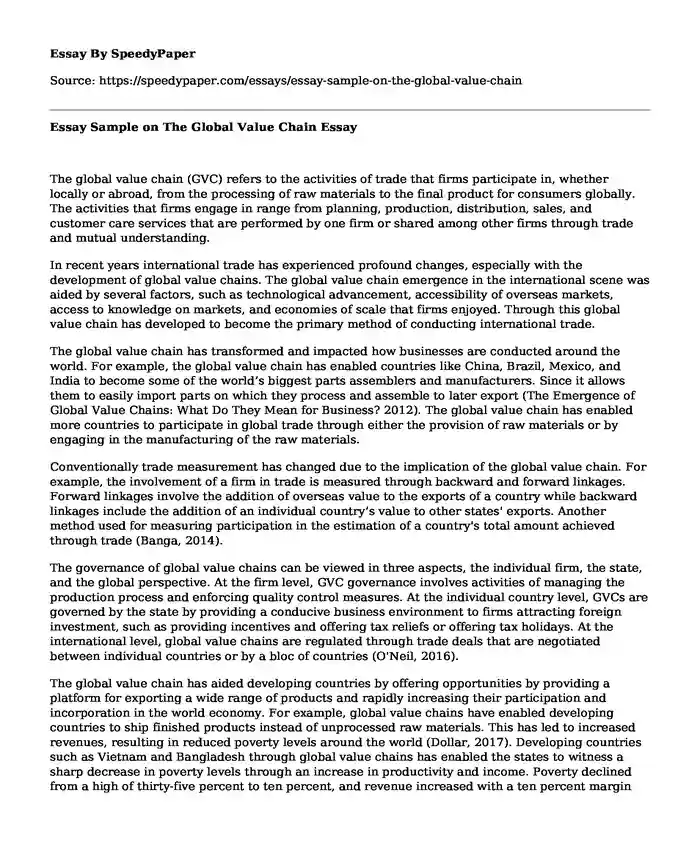
| Type of paper: | Essay |
| Categories: | Globalization Business International relations |
| Pages: | 3 |
| Wordcount: | 621 words |
The global value chain (GVC) refers to the activities of trade that firms participate in, whether locally or abroad, from the processing of raw materials to the final product for consumers globally. The activities that firms engage in range from planning, production, distribution, sales, and customer care services that are performed by one firm or shared among other firms through trade and mutual understanding.
In recent years international trade has experienced profound changes, especially with the development of global value chains. The global value chain emergence in the international scene was aided by several factors, such as technological advancement, accessibility of overseas markets, access to knowledge on markets, and economies of scale that firms enjoyed. Through this global value chain has developed to become the primary method of conducting international trade.
The global value chain has transformed and impacted how businesses are conducted around the world. For example, the global value chain has enabled countries like China, Brazil, Mexico, and India to become some of the world’s biggest parts assemblers and manufacturers. Since it allows them to easily import parts on which they process and assemble to later export (The Emergence of Global Value Chains: What Do They Mean for Business? 2012). The global value chain has enabled more countries to participate in global trade through either the provision of raw materials or by engaging in the manufacturing of the raw materials.
Conventionally trade measurement has changed due to the implication of the global value chain. For example, the involvement of a firm in trade is measured through backward and forward linkages. Forward linkages involve the addition of overseas value to the exports of a country while backward linkages include the addition of an individual country’s value to other states' exports. Another method used for measuring participation in the estimation of a country's total amount achieved through trade (Banga, 2014).
The governance of global value chains can be viewed in three aspects, the individual firm, the state, and the global perspective. At the firm level, GVC governance involves activities of managing the production process and enforcing quality control measures. At the individual country level, GVCs are governed by the state by providing a conducive business environment to firms attracting foreign investment, such as providing incentives and offering tax reliefs or offering tax holidays. At the international level, global value chains are regulated through trade deals that are negotiated between individual countries or by a bloc of countries (O'Neil, 2016).
The global value chain has aided developing countries by offering opportunities by providing a platform for exporting a wide range of products and rapidly increasing their participation and incorporation in the world economy. For example, global value chains have enabled developing countries to ship finished products instead of unprocessed raw materials. This has led to increased revenues, resulting in reduced poverty levels around the world (Dollar, 2017). Developing countries such as Vietnam and Bangladesh through global value chains has enabled the states to witness a sharp decrease in poverty levels through an increase in productivity and income. Poverty declined from a high of thirty-five percent to ten percent, and revenue increased with a ten percent margin from 40 to 50 percent (Goldberg, 2019).
References
Banga, R. (2014). Measuring Value in Global Value Chains. Global Commodities Forum, 1-18.
Dollar, D. (2017, July 2017). Global value chains provide new opportunities for developing countries. Order From Chaos. Retrieved June 5, 2020, from http://www.brookings.eduGoldberg, P. (2019). How important are Global Value Chains for development? World Bank Blogs.
O'Neil, S. K. (2016, August 16). Who Governs Global Value Chains? Council on Foreign Relations.
The Emergence of Global Value Chains: What Do They Mean for Business? (2012, November 5). Retrieved from Organisation for Economic Co-operation and Development: http://www.oecd.org
Cite this page
Essay Sample on The Global Value Chain. (2023, Aug 24). Retrieved from https://speedypaper.net/essays/essay-sample-on-the-global-value-chain
Request Removal
If you are the original author of this essay and no longer wish to have it published on the SpeedyPaper website, please click below to request its removal:
- Free Essay on the Article Global Outlaws: Crime, Money, and Power in the Contemporary World
- Free Essay on Development Factors of the International Leisure Tourism Demand over the Past 20 Years
- Unemployment Compensation, Free Essay Sample
- Outlining, Aristotle's Artistic Proofs, and Rhetorical Stance. Paper Example
- Paper Example. Value Chain and Its Relationship With Supply Chain
- Free Paper Sample on Strategic Management
- Paper Sample on Swiss Luxury Watch Brands
Popular categories




